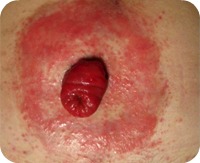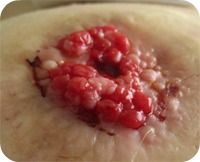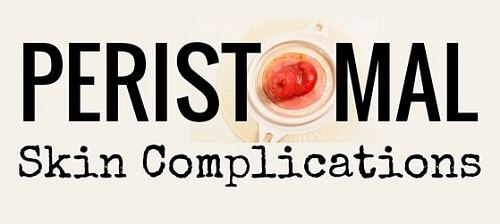This overview details the five main categories of peristomal skin complications that wound specialists commonly treat in ostomy patients.
If you’ve worked with ostomy patients for any length of time, you know that maintaining a proper seal can be difficult once the peristomal skin (the skin surrounding a stoma) has been compromised. The resulting complications can drastically reduce an ostomy patient’s quality of life, and lead to social isolation, anxiety, and depression. Additionally, when patients need to change their pouches multiple times per day, it also poses a tremendous financial burden.
Unfortunately, ostomy patients with peristomal skin complications often don’t even recognize that complications they are experiencing are treatable. They simply accept it as part of their new life with a stoma, and forgo seeking help. The good news is that we are in the position to not only learn more about peristomal skin complications, but also help educate our patients so that when they suffer from complications, they know there are solutions.
The Basics
Peristomal skin complications usually fall into one of five categories:
- mechanical trauma
- infection
- chemicals and irritants
- diseases
- skin allergens
Of all ostomy patients, ileostomy patients have the most complications. That’s because the output from their stomas (the effluent) is watery and caustic. In fact, peristomal skin complications have been estimated to be as high as 57% for patients with ileostomies, 48% with ileal conduits (from urostomies), and 35% with colostomies. Incidentally, the rate of complications in colostomy patients is lower because it’s easier to contain stool, which is more solid.
So let’s get specific and take a closer look at each type of peristomal skin complications.
Mechanical Peristomal Skin Trauma
Mechanical trauma results from pressure, friction, or shear. Pressure can result from an ill-fitting ostomy appliance, ostomy belt or convex pouching system. Friction occurs from abrasive cleansing, improper pouching removal techniques, and frequent appliance changes. The tissue damage can be partial to full thickness.
Peristomal Skin Infections
Peristomal skin is prone to infection from bacteria and fungi. Two common peristomal infections are candidiasis and folliculitis.

Peristomal Candidiasis
Peristomal Candidiasis – This type of infection is an overgrowth of the fungus Candida Albicans surrounding a fecal or urinary diversion. Fungi thrive in warmth, moisture and darkness. So when an ostomy patient experiences perspiration, pouch leakage, denuded skin or prolonged wear time, moisture is added beneath the skin barrier.
Of course, this can provide the perfect environment for fungi to grow. In addition, some patients are simply more predisposed to peristomal candidiasis because of various conditions such as immunosuppression, diabetes, or antibiotic therapy. Such infections can be found anywhere on peristomal skin, but is most commonly found under the skin barrier or under the pouch where it touches the abdomen.
Folliculitis – This is inflammation and/or infection of superficial hair follicles, resulting in isolated lesions or discoloration right at the follicle site. It can be caused by chemical irritation, such as the effluent, or physical injury, such as rough shaving of the peristomal skin, ripping off the skin barrier, or friction of hair follicles under the skin barrier. Staphylococcus aureus, streptococci, and pseudomonas aeruginosa are the most common bacteria found with folliculitis. As with candidiasis, patients with diabetes, immunosuppression or antibiotic therapy are more likely to develop this infection.
Chemicals Irritants
Peristomal Irritant Contact Dermatitis – Following ostomy surgery, as many as 50% of patients experience peristomal irritant contact dermatitis, which is an inflammatory reaction to a chemical that results in well-defined erythema, edema, or loss of epidermis. Papules and vesicles are often present as well. You may know this condition as peristomal moisture associated dermatitis (as discussed in the WCEI blog, MASD: Know Your Types). The chemical irritant can be soap, solvents, or adhesives, but it is often the patient’s own effluent leaking from a poorly fitting pouch or seal. It’s especially prevalent in ileostomy patients because their stoma output is watery and caustic.

Hyperplasia
Hyperplasia – This condition is known by many names: pseudoverrucous lesions; chronic papillomatous dermatitis; hyperkeratosis; granulomas; pseudo-epithelial hyperplasia; exuberant tissue growth; and proud flesh. It’s the result of prolonged skin exposure to urine and moisture. Typical causes include:
- a pouch that is cut too large for the stoma
- patients with high output liquid stool
- urostomy patients, if the skin is in contact with alkaline urine
- a stoma that is flush with surrounding skin or retracted
Hyperplasia presents as patches of discolored, thickened epidermis and papules, nodules, or both.
Alkaline encrustations – In your urostomy patients, you may find crystal-like formations on exposed peristomal skin. These crystals are called alkaline encrustations. When you remove the pouching system, the skin may bleed. This condition is associated with hyperplasia (discussed above), alkaline urine and/or concentrated urine that pools on the peristomal skin, renal calculi or kidney stones, and urinary tract infections.
Disease of Peristomal Skin

Pyodermal Gangrenosum
Pre-existing skin diseases such as psoriasis, eczema, or seborrheic dermatitis can cause issues in the skin surrounding the stoma. But sometimes more serious conditions can develop, such as pyoderma gangrenosum (PG), which is an inflammatory, ulcerative autoimmune disease condition. PG begins as pustules and continues to extremely painful ulcers that may become full-thickness and excavate under the skin. Even though it occurs in 50% of ostomy patients with underlying inflammatory bowel diseases (such as Crohn’s disease and ulcerative colitis), the etiology of peristomal pyoderma gangrenosum remains unknown.
Peristomal Skin Allergens
Peristomal Allergic Contact Dermatitis – Contact skin allergies are fairly common in the population, so it’s not surprising to find that some ostomy patients have allergic reactions to pouching systems, accessories or skin care products. Many patients develop a peristomal contact allergy only after repeated exposure to the offending product, or if they are sensitized to a related cross-reacting substance. Allergic reactions typically include erythema along with itching, papules, vesicles, discoloration, crusting, oozing, or dryness.
Suture Granulomas – Suture granulomas are granulation tissue at the suture skin interface and are a reaction to suture material. These present as scattered, red areas of friable granulation tissue where sutures are present.
Simply Put
Peristomal skin complications not only prevent proper pouching, they undermine the comfort and well-being of our patients. And as always, our mission is to help patients heal and enjoy a higher quality of life whenever possible. By understanding the different types of complications and combining treatment with patient education, we can fulfill that mission tenfold.
To learn more about peristomal skin complications (and earn an education credit while you’re at it), view the WCEI webinar, “Troubleshooting Peristomal Skin Complications.” You’ll find out more specifics about this topic, including clinical characteristics and treatment plans.
What do you think?
Were you already familiar with the five common types of peristomal skin complications? And do you have any particularly challenging cases that relate to ostomy patients and one of these types of complications? We would enjoy hearing all about your clinical experiences regarding this topic. Leave your comments or questions below.
Wound Care Education Institute® provides online and onsite courses in the fields of Skin, Wound, Diabetic and Ostomy Management. Health care professionals who meet the eligibility requirements may sit for the prestigious WCC®, DWC® and OMS national board certification examinations through the National Alliance of Wound Care and Ostomy® (NAWCO®). For more information see wcei.net.
What do you think?

